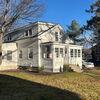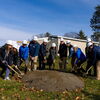Processing Your Payment
Please do not leave this page until complete. This can take a few moments.
- News
-
Editions
View Digital Editions
Biweekly Issues
- Nov. 17, 2025
- November 03, 2025
- October 20, 2025
- October 6, 2025
- September 22, 2025
- September 8, 2025
- + More
Special Editions
- Lists
- Viewpoints
-
Our Events
Event Info
Award Honorees
- Calendar
- Biz Marketplace
Millinocket co. unearths logging history for niche market
 PHOTo / Darren Fishell
Maine Heritage Timber co-founder Tom Shafer stands near the shore of Quakish Lake in Millinocket. His company, incorporated under the name Great Northern Timber LLC, recovers logs from the bottom of the lake and fashions them into high-end flooring.
PHOTo / Darren Fishell
Maine Heritage Timber co-founder Tom Shafer stands near the shore of Quakish Lake in Millinocket. His company, incorporated under the name Great Northern Timber LLC, recovers logs from the bottom of the lake and fashions them into high-end flooring.
 PHOTo / Darren Fishell
Jim Ewing, who oversees wood finishing for Maine Heritage Timber, sands out a burl of reclaimed wood to make a bowl. The company opened a wood shop next to its main warehouse last October to create custom and specialty products.
PHOTo / Darren Fishell
Jim Ewing, who oversees wood finishing for Maine Heritage Timber, sands out a burl of reclaimed wood to make a bowl. The company opened a wood shop next to its main warehouse last October to create custom and specialty products.
Nobody expected the waterlogged wood lining the bottom of Quakish Lake would become anything but pulp.
But Tom Shafer is harvesting that wood for a new purpose. And it's given him a new purpose, too.
For two decades, Shafer chased down daily profits as a market maker on the floor of the New York Stock Exchange. Now, instead of quick returns, he and Steve Sanders, co-founders of Maine Heritage Timber Co., plan to cash in on an investment that's taken centuries to mature: the market value of unique wood locked in logs stacked deep in the silty bottom of that 1,000-acre lake in Millinocket.
Shafer says between 700,000 to 1 million cords of wood — enough to harvest for around 20 years — is estimated to have sunk into the lake during log drives to Great Northern Paper's nearby mill. For the past two years, Maine Heritage Timber has been reclaiming the mostly century-old wood. In the first year, most of the logs were turned into pulp to feed biomass boilers. But in the last year, Shafer has been seeking a niche market that promises a much greater return for the wood — high-end flooring.
"Last year, we did about 90% biomass and pulp and 10% flooring and furniture. This year, I hope that it's 80% flooring and furniture and 20% biomass," Shafer says. "The only thing that I want to [sell for] biomass is the stuff that I can't saw."
Shifting gears
The journey from pulp to upscale floor planks was a surprise to Shafer. Until late 2012, he and Sanders saw the sunken forest on the lake's bottom much the way the loggers who cut it a century ago had likely seen it: a source to make paper.
Sanders had worked with the original Great Northern Paper Co. , which filed for bankruptcy in 2002, to assess the quantity of sunken logs in Quakish Lake. Although the mill abandoned its reclamation projects and Sanders eventually became a builder in the Portland area, he returned in 2010 to negotiate permission to harvest the sunken wood. With Shafer's prowess for finding investment capital and Sanders' working knowledge of harvesting wood, the two started their own company.
In 2010, "we thought we were going to take this wood out [of the lake] and deliver it in full containers to the mill," Shafer says. "They were going to process the wood and we were going to sell it for pulp."
Then, in early 2011, the East Millinocket pulp mill shut its doors. That unexpected turn pushed Maine Heritage Timber to change direction and buy its own sawmill to mill wood for value-added products, like flooring and custom furniture.
It's taken over a year to pivot the business, says Shafer, to perfect processes for cleaning the wood and finding manufacturers to help with production. To shore up the financing, Shafer found another investor — whom he declined to name — to join him and Sanders. That tight-knit financing structure has been key in allowing the company to transform, Shafer says.
If they had any more investors, Shafer says, "we'd be out of business because our business model has changed so drastically."
Last October, the company expanded its operation on the Golden Road to include an office building next to its milling and maintenance buildings — all leased from Pittsfield-based Cianbro Corp. Two seasoned woodworkers now make cuts of sample wood and custom products for clients and trade shows in the former office building.
Last year, the company spent about $1.2 million in operating expenses and recorded about $600,000 in revenue. The owners are banking on the success of the high-end flooring line to really vault the company into profitability.
Three products comprise the line: the spruce and fir Riverdriver Collection; the yellow birch and red oak 1899 Collection; and the eastern white pine Penobscot Collection. They are all "engineered flooring," where a wear layer of quarter-inch reclaimed wood is hot-glued to a half-inch layer of 11-ply Baltic birch. They sell for $9.50 to $13 per square foot, unfinished.
That type of construction allows the company to multiply, for example, the 13,000 dried board-feet unloaded at its Golden Road warehouse in mid-April into about 39,000 feet of flooring. The engineered construction technique enhances the final product, according to Robert Rice, a University of Maine wood scientist who worked with Shafer to develop Maine Heritage's products.
"It makes the flooring system stronger and more capable of withstanding shock," Rice says.
Shafer plans to harvest 12,000 tons of logs from the lake this year — less than half of what was pulled from Quakish in 2012 — to keep the saws running year round.
And the target customer is someone Shafer knows well: himself, a decade ago.
Working on Wall Street for the Dutch firm Van der Moolen, he pulled in about $1 million a year, maintaining a home in Connecticut, an apartment in the city and a parking space that cost as much per month as the rent he now pays on his Millinocket home. The market for Maine Heritage Timber is homes in the $500,000 and up range.
Currently, the flooring is in 10 homes, which Shafer says should increase tenfold by the end of the year. Although the line is marketed to emphasize its Maine logging tradition roots, New England, so far, has not been a booming market.
That's an observation shared by Todd Morrissette, who has exhumed hardwood from Moosehead Lake and other state-owned lands for his DeadHead Lumber Co., for five years. Morrissette says the market for his river-reclaimed wood flooring has typically been strongest farther south.
"… [H]istorically, it was in New York [and] the South and on the West Coast, but I'm seeing more sales in New England," he says, a trend that is making this year his best since starting the company, which he attributes to a recovering economy.
Morrissette sells primarily hardwood flooring, and Shafer acknowledges there is enough yellow birch and red oak on the bottom of Quakish Lake to sustain a hardwood line for Maine Heritage. But Shafer is focusing on higher-end uses for the softwood species that have settled to the lake's bottom, the byproduct of trillions of board-feet of spruce and fir that floated down the Penobscot River to make paper.
The choice to pursue higher-value uses for softwood comes down to simple math, says Shafer. A package of the company's spruce fir wainscoting weighs around 35 lbs. and carries a wholesale price of about $70.
"We get around $49 a ton — for 2,000 lbs. — of biomass," Shafer says. "So, what business do you want to be in?"
Even within the specialty wood market, Maine Heritage is jockeying to carve out a niche for its brand of reclaimed flooring. It's why Shafer makes a point of using the phrase "river reclaimed" in his marketing materials to describe his product lines.
"We get calls all the time from people trying to sell us Heart Pine [to make into flooring] from the middle of industrial facilities that have been demolished," Shafer says. "But that's been sitting in a place covered in asbestos and lead paint for 150 years and you think you got all the toxins out of there?"
While unexposed to such toxins, not all of the century-old wood dredged up from the lake bottom is in ship shape. Maine Heritage culls the logs for a variety of products and, for those that don't make the cut into flooring, furniture or wainscoting, it's on to the pulp mill or biomass boiler.
The wood that's recovered from the lake bottom in many ways dictates what, and how much, can be made.
In the company's wood shop, where craftsmen Shenon Parker and Jim Ewing have been at work since October, a small storage room holds some of the treasures that have been fashioned from the sunken logs, like a $5,000 table made of beech wood.
"When this is done, I don't know if I'm ever going to find another piece of beech," Shafer says.
Parker, who spent most of his woodworking career in a cabinet or carpentry shop, says he enjoys the challenge of the company's custom work.
"What you build is dictated by the wood," Parker says. "And you just can't find this wood anywhere else."
Rice, the wood scientist, concurs. The cold and oxygen-free lake environment preserves the wood and, when sawed, it can expose naturally occurring coloration that's hard to find elsewhere, primarily because it takes centuries — and an element of circumstance — to happen.
"The only thing that's consistent is the inconsistency of the patina in the wood," Shafer says. "If you're a homeowner and you say you want a blonde, maple floor, I'd say, 'It's really nice to meet you, but I can't provide you with that.'"
Selling Maine
Although his trek from Manhattan to Millinocket seems incongruous, Shafer has always been familiar with Maine's North Woods. His grandfather, an engineer, came to Millinocket in the early 1900s to work on a dike on Ambajejus Lake for the original Great Northern Paper Co.
Since then, the family has kept a camp in Millinocket. Shafer arrived after Wall Street's collapse when his uncle invited him there to serve as general contractor on a renovation project he wanted a family member to lead. It was a healing period, Shafer says, but it was also where he met his new business partner and deepened his understanding of the history he now sees as essential to his company's success.
"When I go to sell, I need to spend 20 minutes educating [a potential customer] on the story," Shafer says. "This project is everybody's heritage up here."
To honor that heritage, the company first operated under the name West Branch Heritage Timber, a reference to the west branch of the Penobscot River. But now it is transitioning to Maine Heritage to connect with a wider audience.
"Maine is a very powerful brand," Shafer says. "The west branch of the Penobscot is not so powerful and we were a little bit provincial when we came up with it."
But the state's logging heritage lies at the foundation of its brand. Shafer likes to talk about the forests that provided the masts of royal ships in England and fed a burgeoning Industrial Revolution as forerunners to his use for the sunken logs. He notes that the wood at the bottom of Quakish Lake is old-growth timber, harvested from largely undisturbed forests.
"These timbers provided the livelihood for dozens and dozens of people for many years," says Rice. "And it was done with slow-harvesting methods and it was done only periodically."
That brand has niche appeal. Last year, L.L.Bean sourced all of the wood for its commemorative 100th anniversary canoe paddles from Shafer's company.
And there are the intangibles. Spotting a bald eagle circling above Quakish, Shafer admits he rarely misses his days on Wall Street.
"We're going on a treasure hunt every day," Shafer says of his new line of work. "If we didn't have to pay the bills, this would be the funnest thing in America."
Maine Heritage Timber Co.
The process
“Countless logs resting in lakes, ponds and rivers offer a good income to divers willing to take up the challenge,” wrote Bangor historian John E. Cayford in his 1964 book “Underwater Logging.”
While the concept of underwater logging is not new, few have made a go of large-scale timber reclamation efforts.
In the two years since starting Maine Heritage Timber, Tom Shafer and Steve Sanders learned why.
“In your head it sounds great,” says Sanders. “You'll bring it up, saw it out and make something nice with it. But it takes a lot to get it from the lake to a finished product.”
Here's what's involved:
Locating: For decades, the lake served as a holding pen for logs that had been driven down the Penobscot River on their way to the Millinocket mill. There are so many logs on the lake's bottom that harvesters need only to pay attention to areas where they've already worked to find new deposits.
Harvesting: A $600,000 modified crane sits atop barges in various configurations to harvest the wood. The crane is lowered into the water of Quakish Lake and grabs a bundle of logs, hoisting them to the surface and depositing them on barges anchored nearby.
Cleaning: Once hauled to shore, the logs are moved across a large shaker screen to knock off mud and debris that's later processed as topsoil and sold.
Sorting: Logs are assessed for best value, whether flooring, furniture or pulp.
Sawing: Suitable logs are sawed in Millinocket then sent away to be kiln-dried.
Processing: Dried boards are culled, a portion going to make wainscoting and another portion to make flooring, which is manufactured at Renick Millworks in Renick, W. Va.
Sales: Shafer is the company's lead salesman, using his New York, Connecticut and New Jersey connections to reach builders and homeowners.
Mainebiz web partners
Related Content

The Giving Guide
The Giving Guide helps nonprofits have the opportunity to showcase and differentiate their organizations so that businesses better understand how they can contribute to a nonprofit’s mission and work.
Learn More
Work for ME
Work for ME is a workforce development tool to help Maine’s employers target Maine’s emerging workforce. Work for ME highlights each industry, its impact on Maine’s economy, the jobs available to entry-level workers, the training and education needed to get a career started.
Learn More
Groundbreaking Maine
Whether you’re a developer, financer, architect, or industry enthusiast, Groundbreaking Maine is crafted to be your go-to source for valuable insights in Maine’s real estate and construction community.
Learn more-
The Giving Guide
The Giving Guide helps nonprofits have the opportunity to showcase and differentiate their organizations so that businesses better understand how they can contribute to a nonprofit’s mission and work.
-
Work for ME
Work for ME is a workforce development tool to help Maine’s employers target Maine’s emerging workforce. Work for ME highlights each industry, its impact on Maine’s economy, the jobs available to entry-level workers, the training and education needed to get a career started.
-
Groundbreaking Maine
Whether you’re a developer, financer, architect, or industry enthusiast, Groundbreaking Maine is crafted to be your go-to source for valuable insights in Maine’s real estate and construction community.
ABOUT
NEW ENGLAND BUSINESS MEDIA SITES
No articles left
Get access now
In order to use this feature, we need some information from you. You can also login or register for a free account.
By clicking submit you are agreeing to our cookie usage and Privacy Policy
Already have an account? Login
Already have an account? Login
Want to create an account? Register
Get access now
In order to use this feature, we need some information from you. You can also login or register for a free account.
By clicking submit you are agreeing to our cookie usage and Privacy Policy
Already have an account? Login
Already have an account? Login
Want to create an account? Register











Comments